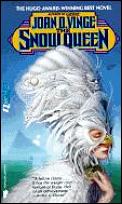
| Publisher: | Questar |
| Copyright: | 1980 |
| Printing: | September 1989 |
| ISBN: | 0-445-20529-6 |
| Format: | Mass market |
| Pages: | 469 |
It felt like Vinge was trying too hard with this book.
The Snow Queen is set on a world whose star is in a long orbit around a black hole. The black hole is part of an ancient transit system that unites the dozens of worlds of civilization as it currently exists, and while that passage is open, the world of Tiamat is particularly accessible and convenient. During those periods, the Winters rule, strong with technology and alien influence. When Tiamat's star approaches perigee, however, the black hole becomes unstable, cutting Tiamat off from interstellar contact for over one hundred years, and the aliens take away their technology when they go. During this time, the Summers rule, islanders with no taste for technology and a distrust of anything non-native.
This is just the beginning of Vinge's world-building. There is also the belief of the Summers in an ocean god, the mysterious sibyls who seem to carry the knowledge of that god and will answer any question, the slaughter of native and harmless creatures of Tiamat for a drug used by the universe's elite for immortality, an intensely cast-conscious culture that currently controls interstellar trade, and the remnants of a fallen empire. Vinge is trying to work on a grand scale, and there are enough good ideas to pull it off. Unfortunately, the quality of the storytelling isn't quite up to the task.
With Tiamat serving as the sole source of an immortality drug, and with some of the corrupt politics falling out of that, I can see the cover comparison to Dune. The difference, though, is that Dune has philosophy and characters to match, whereas The Snow Queen's characters felt simplistic, fitting into slots in the story and the world rather than finding their own voices. This really hurts the emotional effect. Significant events are met with predictable and sometimes melodramatic actions, like the characters are trying too hard to fit their roles but are a bit too shallow to pull them off. This is particularly bad towards the end of the book, where many of the emotional climaxes rang false for me or were resolved far too quickly.
The world background is great, though. I've gotten tired of crumbling empires in fantasy, but remnants of vast interstellar empires still capture my imagination. The sibyl concept is handled beautifully, even if I did guess a couple of revelations in advance, and becomes more interesting the more that I learned about it. I may end up reading The Summer Queen for the sibyls alone; I want to see how that part of the story ends. The world and the epic sweep of Vinge's vision did keep me interested, but I regretted the missed opportunities for most of the book.
Most of the plot centers on Moon, a sibyl and a Summer who never dreamed of the size of the universe outside of her goddess religion and life on the sea, and Arienrhod, the queen of the Winters. They are supposed to work as a pair in the story, playing off of each other, contrasting, and finally confronting each other in the emotional climax of the book. Moon is, by far, the deepest character in the book, and even still this confrotation never works. The emotional scenes sound flat, the resonance is missing, and the emotions are never quite strong enough. Similarly, Jerusha, the off-world police officer who plays a central role in the Airenrhod side of the story, started well but then develops a fanatical attachment to the letter of the law. This gives rise to endless angst that didn't ring true for me and didn't seem to fit with the rest of her character. It's a shame; the story could have been much more powerful.
Other signs of trying a bit too hard abound. There are a lot of characters and nearly all of them get a turn at being the viewpoint character. The Summers, other than the two viewpoint characters who leave that culture, get lost in the rest of the world building and only show up as a plot device at the end. And Vinge occasionally gets a bit too cute with descriptions; there is, for instance, a "high-albedo" robot. The English language is rich with words like "reflective," "polished," or even "shiny"; using an unnecessary scientific term is a bit jarring and throws the reader, however briefly.
Despite this, I'm glad I read it. The information system of the sibyls and the hints of how it works that unfold over the course of the story were enough to keep me interested by itself. Unfortunately, though, this is one of those idea books where one has to read past somewhat clunky technique, so I can't wholeheartedly recommend it.
Followed by World's End.
Reviewed: 2005-07-16